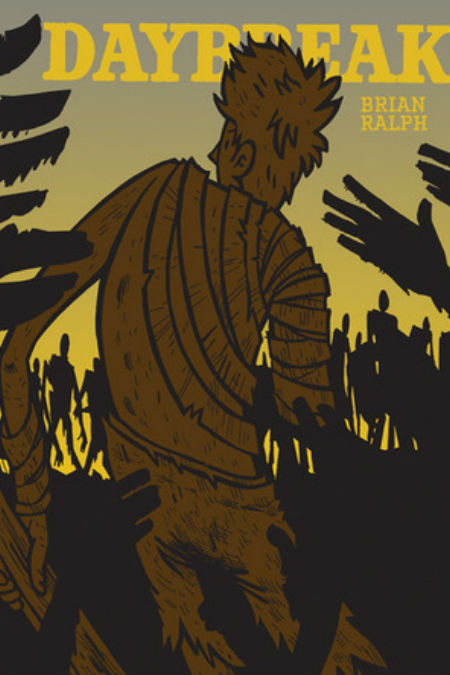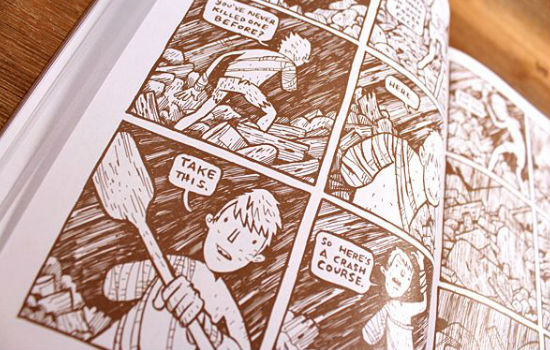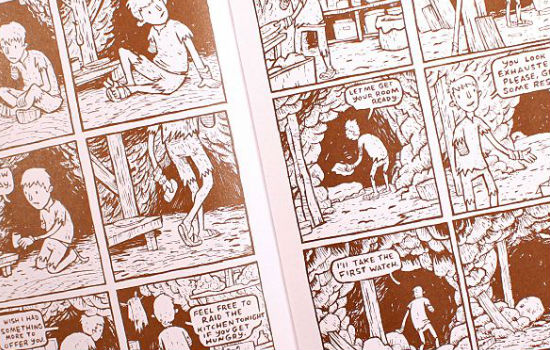
There is a tendency in apocalyptic literature to go for the frenetic juggler narrative-wise.
Given the scenarios usually at play, this is reasonably understandable since we’re generally talking epic fights for survival and not a stroll in the park on Sunday.
The problem with going hard and big, a syndrome that afflicts shows like The Walking Dead, either positively or negatively depending on your vantage point, is that a great deal of the nuance that could really make a story set in an apocalyptic landscape is lost.
This is important because even in tales that take place in worlds beset by some world-ending nightmare or another, people are still people and not everything occurs in finale-producing fashion.
Daybreak, a wholly original and imaginatively-executed graphic novel from Brian Ralph (Cave-in) understands this dynamic all too well, delivering up a story which acknowledges the gravity of the setting – earth lost to the undead with much of the world in unexplained ruins (was it bombing to stop them? General decay over time? We’re never told but honestly, it doesn’t matter, it’s just there) – but lets the raw humanity of the characters drive the story.
In fact, the zombies, who are unnervingly more active and faster at night when survivors are at an obvious disadvantage, aren’t ever front or centre in the action, though they are, for obvious reasons, one of the key narrative drivers.
Rather, what we see the most of are the survivors – both the one-armed, nameless and endlessly cheerful guy who does all the talking and you the reader as the rescued survivor who is never pictured but who becomes part of a team with the plucky man who lifts you out of harm’s way.
The brilliance of Daybreak, a clever title with many reference points the most obvious being the point at which the destroyed landscape that is what’s left of civilisation, is that it manages to craft a compelling, propulsive story out of a slow-burning, never-rushed series of events that owe as much to our innate humanity as they to the animalistic undead who are a constant threat throughout the book.
In so doing it avoids the trap of so many apocalyptic thrillers that prioritise action over character development, epic moments of truth over small but vital moments of humanity, offering up a story that matters because the people in it matter.
They matter a great deal in fact, granting us a window into a world with little to no set-up, which is ravaged and full of loss and deprivation but also, as our plucky, resourceful rescuer makes clear, all kinds of opportunities and possibilities for hope if you know where to look for them.

Daybreak‘s masterful ability to quietly and without unnecessary fuss balance the big apocalyptic moments with the smaller day-by-day developments that ultimately have more impact for our survivors is one key reason why the novel works so well.
It understands, in a way that stories like The Girl With All the Gifts/The Boy on the Bridge and Station Eleven implicitly acknowledge, that all the good does not flee from the soul of humanity when calamity strikes, nor does our capacity for hope and expectations for a better future.
Sure, many people area nasty bunch of self-interested Darwinian-type fiends or just plain mad and lost in their own inability to sanely process the insane events around them, with the only other character in the book representing that all too common type of broken survivor, but there are also those who still see value in helping and uplifting others.
It’s a reassuring thread true but it is also realistic, and as the companionship builds between rescuer and rescued, and events build and build in both threat and unpalatable realisation, you are drawn into the idea that life may be bleak and awful in one sense but that there remains the ability for the world to be nourishing and hopeful too.
So well does Daybreak draw both the horror and the hope, often in the same scenes, that you can’t help but become invested in the lives of everyone in the book.
Even the deranged old man who causes them so much trouble that he triggers a turn for the worse for all parties, comes equipped with enough humanity that you can’t help but feel for him; after all, who among us wouldn’t find ourselves tempt with an easy slide into madness when faced with the loss of pretty much everything and everyone we have ever held dear.
Ralph is at every turn a concise and elegantly-gripping storyteller, a writer and illustrator who understands the deleterious effects that would plague the human psyche in an apocalyptic world, but also appreciates that for all the nightmare and horror, there is also the capacity for the best part s of the human spirit to prevail, even when by rights there should no sign of them.
The ending is a thing of heartbreaking beauty, holding the balance taut between bestiality and humanity, loss and gains, bleakness and hope, and reminding us that even in the very worst of times, and there are plenty of them in Daybreak, that the best of times are also possible, and very much still a part of the fabric of human existence.
